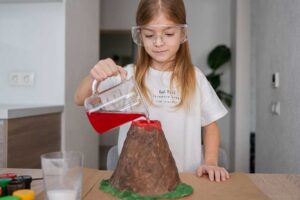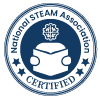
In today’s rapidly evolving educational landscape, the integration of Science, Technology, Engineering, Arts, and Mathematics (STEAM) has become paramount in fostering holistic learning experiences for children. If you’ve created a toy, book, or game that promotes STEAM education, earning accreditation from the National STEAM Association can significantly enhance its credibility and reach. This blog post will guide you through the process of obtaining STEAM accreditation for your creation.
Understanding the Importance of STEAM Education:

A little girl pours activator into a STEAM volcano kit.
Before delving into the accreditation process, it’s crucial to recognize the significance of STEAM education. STEAM not only encourages critical thinking and problem-solving skills but also nurtures creativity and innovation in young minds. By aligning your toy, book, or game with STEAM principles, you contribute to the development of well-rounded individuals ready to tackle future challenges.
The National STEAM Association:
The National STEAM Association is a reputable organization dedicated to promoting STEAM education across various platforms. They offer accreditation for products that effectively incorporate STEAM principles into their design, ensuring they meet the highest educational standards.
Steps to Earn STEAM Accreditation:
1. Research STEAM Guidelines:
Before applying for accreditation, familiarize yourself with the National STEAM Association’s guidelines. Understand the specific criteria your product must meet to be considered for accreditation. This may include demonstrating how your creation aligns with STEAM principles and enhances learning in each discipline.
2. Align Your Product with STEAM:
Review your product to identify and highlight its connections to Science, Technology, Engineering, Arts, and Mathematics. Clearly articulate how your toy, book, or game promotes active learning and engages children in meaningful ways across these disciplines.
3. Develop Educational Resources:
Create supplementary materials that educators and parents can use to enhance the educational value of your product. This could include lesson plans, activity guides, or online resources that align with STEAM curricula. Demonstrating the educational support your product offers can strengthen your accreditation application.
4. Document and Showcase:
Compile comprehensive documentation that showcases how your product meets the STEAM criteria. This may involve providing detailed descriptions, images, and videos that highlight the educational aspects of your creation. The National STEAM Association often requires evidence of real-world applications and impact, so be prepared to share success stories or testimonials.
5. Submit Your Application:
Once you have all the necessary documentation, submit your application to the National STEAM Association. Ensure that your submission is thorough and well-presented. Clearly communicate how your product contributes to STEAM education and the positive impact it can have on learners.
6. Await Evaluation:
The National STEAM Association will review your application and assess whether your product meets their accreditation standards. Be patient during this process, and be prepared to provide additional information if needed.
Conclusion:
Earning a STEAM accreditation from the National STEAM Association is a significant achievement that can elevate your toy, book, or game in the educational market. By aligning your creation with STEAM principles and providing evidence of its educational impact, you not only contribute to the advancement of education but also open doors to new opportunities and audiences.
Embrace the power of STEAM education and position your product as a valuable asset in shaping the future of learning for children around the world.
